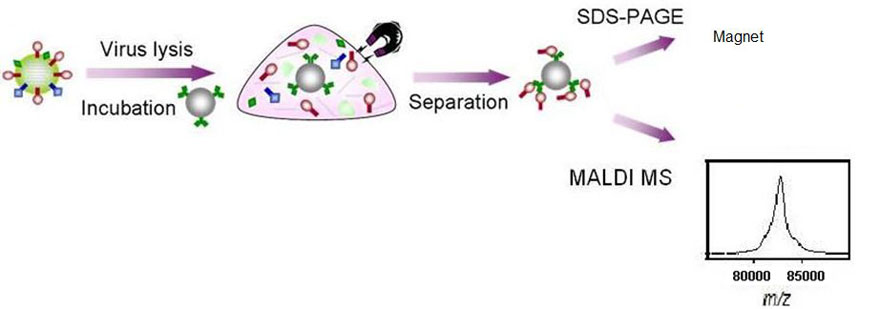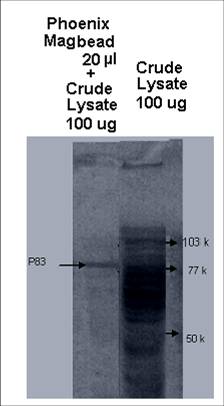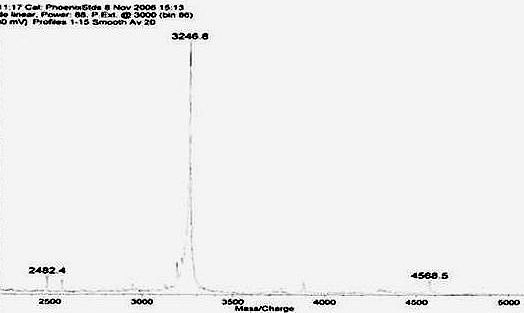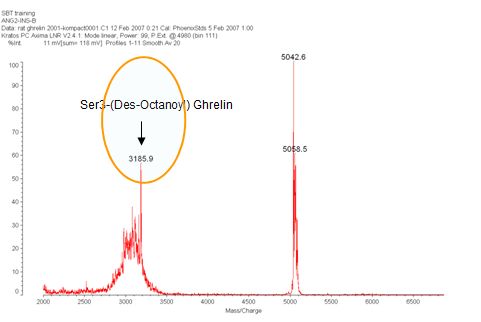|
|
|
Phoenix's Magnetic Beads |
| Coated Beads a Powerful Tool for Peptidomics |
SUMMARY
Peptidomics is the global biochemical profiling of complex biological systems. A peptidomic analysis identifies and measures changes in bioactive peptides and its metabolites in response to disease, drugs, diet and environmental effects. By monitoring hundreds of changes across many peptides and biochemical pathways, areas of significant biological perturbation can be rapidly identified.
Many sample types: 10-1000ul from human, knock-out mice plasma/serum, CSF, tissue or culture extract etc.
Economical: Save time, reagents and obtain test results in short periods vs. traditional immunoassay
Convenient: Apply magnetic field to speed-up processing time- 10 minute incubation vs overnight for RIA
Automated Processing: Comparable with magnetic washer or Kingfisher 96 well plates
Accuracy/Recovery: 75-100% recovery
Easily Accesible Results: Read quantitative results with: Chemiluminescence or radioimmunoassay
Preserve Results: Protect trapped analytes from degradation
1. Enrich, discovery, preserve and screen low-level Biomarkers directly from complex biological samples
2. Validate the immunoassy and speeding-up assay results
3. Cataloging and profiling the prepro-protein generated fragments to integrate the regulation of physiological hormone
4. High-throughput analysis of possible post-translational modification
Example of Affinity purification of p83 protein from Borrelia lysates. In a 1.5ml eppendorf tube, 0.2 ml antibody conjugated magnetic particle was mixed with 0.2 ml of Borrelia lysate. The right figure is the comparison on SDS-PAGE for those eluents from mixtures of lysates with antibody conjugated particles or mock particle (other antibody conjugation). The lane 1 is Borrelia Lysate eluent from Phoenix Magbead, mixed with crude lysate, Lane 2 is 100 ug of original Borrelia Lysate on gel only. Here magnetic beads are successfully used for the recovery of proteins expressed in the form of inclusion bodies, involving at first chemical extraction from the host cells, then adsorptive capture of the target protein onto small magnetic adsorbents, followed by rapid collection of the product-loaded supports with the aid of high gradient magnetic fields. The whole procedure requires less than 60 minutes to see results.

 |
| Catalog Number |
Product Name |
Application |
| MB-031-30 |
Anti-Ghrelin MagBead (Human) |
Capture of ghrelin which can be confirmed by MALDI-TOF MS |
| MB-031-31 |
Anti-Ghrelin MagBead (Mouse, Rat) |
Capture of ghrelin which can be confirmed by MALDI-TOF MS |
| MB-005-SA |
Streptavidin MagBead |
Capture of biotin-labeled molecules (peptides, proteins, antibodies) or cells |
| MB-PRA |
Protein A MagBead |
Capture IgG antibody on beads
Enough to purify 1.5 mg of antibody |
| MB-HIGG |
Anti-Human IgG MagBead |
Purification of human IgG or separation of cells |
| MB-MIGG |
Anti-Mouse IgG MagBead |
Purification of mouse IgG or separation of cells |
| MB-ALB |
Anti-Albumin (Human) MagBead |
Capture of albumin or depletion of albumin from samples |
| MB-GAR |
Goat Anti-Rabbit Serum MagBead |
Capture rabbit antibody for purification |
|

Rat plasma Ser3-(Des-Octanoyl) Ghrelin ( M.W. 3188.64 +/- 3)
captured by Anti-Ghrelin Magbead and revealed by MALDI-TOF

A RP-HPLC and micro-sequence to identify neuronostatin peptide from the somatostatin gene.
Neuronostatin Encoded by the Somatostatin Gene Regulates Neuronal, Cardiovascular, and Metabolic Functions.
J. Biol. Chem. 2008 Nov. 14; 283(46): 31949-59
Faster Immunoassay, Validate Results
Only 5 to 40 µl of
sample are necessary for accurate peptide level determination using Phoenix's
new Magnetic Bead RIA kits,?providing the key to research that was previously
impossible. This versatile and convenient method does not require extraction
and is ideal for samples from mice, infant subjects, CSF.

|
--No Extraction Necessary |
|
--Only 5 to 40 µl required |
|
--Faster than traditional RIA |
|
--Measure serum, plasma, CSF, tissue extract, and more |
|
--Inter- and intra-assay variation of less than 10% |
|
--75%-100% Recovery |
|
--Conventional gamma-counter |
Once samples are enriched, they are eluted from the Magbeads and spotted directly onto a MALDI plate with matrix. When used with the MALDI-TOF mass spectrometer, Magbead-enriched samples are analyzed rapidly and reproducibly in a fully automated format.
Shown here is an example of ghrelin profile analysis from mouse plasma without DPP IV inhibitor by using Anti-Ghrelin Magbead and revealed using MALDI-TOF.
1. Peptide immunoaffinity enrichment coupled with mass spectrometry for peptide and protein quantification.
Whiteaker JR, Paulovich AG, 184-96. Clin Lab Med. 2011 Sep;31(3):385-96.
2. Rapid and specific influenza virus detection by functionalized magnetic nanoparticles and mass spectrometry.
Chou TC, Hsu W, Wang CH, Chen YJ, Fang JM. J Nanobiotechnology. 2011 Nov 16;9(1):52. [Epub ahead of print]
3. high-flow peptide immunoaffinity enrichment and nanoflow LC-MS/MS: assay development for total salivary pepsin/pepsinogen.
Neubert H, Gale J, Muirhead D. Onine Clin Chem. 2010 Sep;56(9):1413-23.
4. Neuronostatin encoded by the somatostatin gene regulates neuronal, cardiovascular, and metabolic functions.
Samson WK, Zhang JV, Avsian-Kretchmer O, Cui K, Yosten GL, Klein C, Lyu RM, Wang YX, Chen XQ, Yang J, Price CJ, Hoyda TD, Ferguson AV, Yuan XB, Chang JK, Hsueh AJ. J Biol Chem. 2008 Nov 14;283(46):31949-59.
5. Quantification of thyroglobulin, a low-abundance serum protein, by immunoaffinity peptide enrichment and tandem mass spectrometry.
Hoofnagle AN, Becker JO, Wener MH, Heinecke JW. Clin Chem. 2008 Nov;54(11):1796-804.
6. Application of proteomic technology in identifying pancreatic secretory trypsin inhibitor variants in urine of patients with pancreatitis.
Valmu L, Paju A, Lempinen M, Kemppainen E, Stenman UH. Clin Chem. 2006 Jan;52(1):73-81.
|
| |
|
|
pnxnews_000000472;
%magbead%
|
|
|


